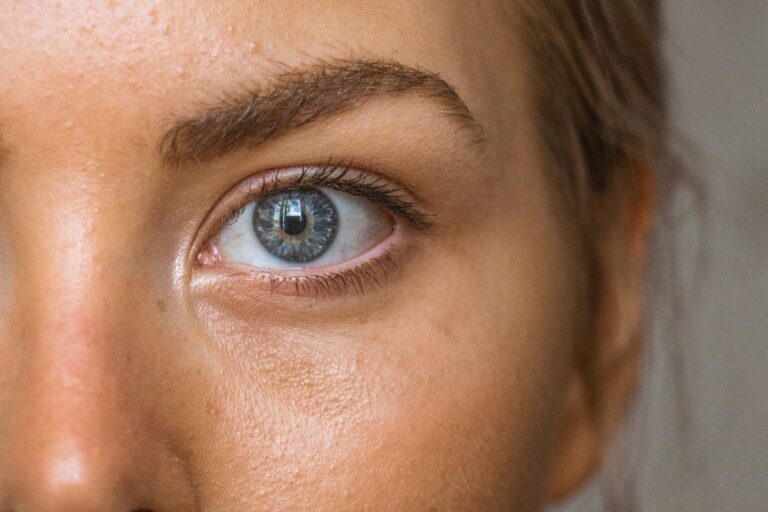When hearing the term color blindness, you might compare it to the condition of being completely sightless. It may bring to mind someone being unable to see any colors, resulting in a world which resembles classic television. However, the reality of color blindness is actually much different.
Imagine being in the paint aisle at a home improvement store, surrounded by hundreds of multi-hued paint chips and being unable to clearly see the difference between red and green shades or blue and yellow. Some reds appear more green or even black. Shades of yellow may look more like gray. This is what color blindness can be.
Human beings have what is called trichromatic color vision, which allows us to perceive the long, medium, and short waves of the light spectrum and our brains translate this information into red, green, blue and the shades in between.

Our eyes have different elements than those of animals and these elements give us the ability to detect more colors of the spectrum. The cones are the part of our eye, which contain the molecules responsible for the perception of the spectrum of light before our brain translates that information in color. They contain pigment molecules in the primary colors of red, green, and blue, which respond to different wavelength of light. When one of the pigments is deficient or not present, this causes the perception of other colors to be skewed.
What Causes Color Blindness?
Color blindness is a genetic condition that is caused when the color detecting parts of our eyes, the cones, lack some of the molecules the body needs to see all the shades of a color. It affects males for than females because the X gene carries it, of which men have two, making it a dominant feature.
Injuries to the eye or chemicals may affect how the eye perceives colors. If the cones are damaged in any way, then so is the ability to differentiate between shades of color. Color perception may decline with age as well and can be affected by cataracts, a film that covers the eye.
Types of Color Blindness
There are three main types of color blindness:
- Red-Green Color Blindness
- Blue-Yellow Color Blindness
- Monochromatic or Complete Color Blindness
There are also varying degrees of severity within each category of color blindness. Some people experience a mild form, which may have little to no impact on everyday life and may not ever be aware of unless they attempt one of the more subtle versions of a colorblind test. There may also be more severe effects, which may require adaptations in order to function safely in the everyday world.
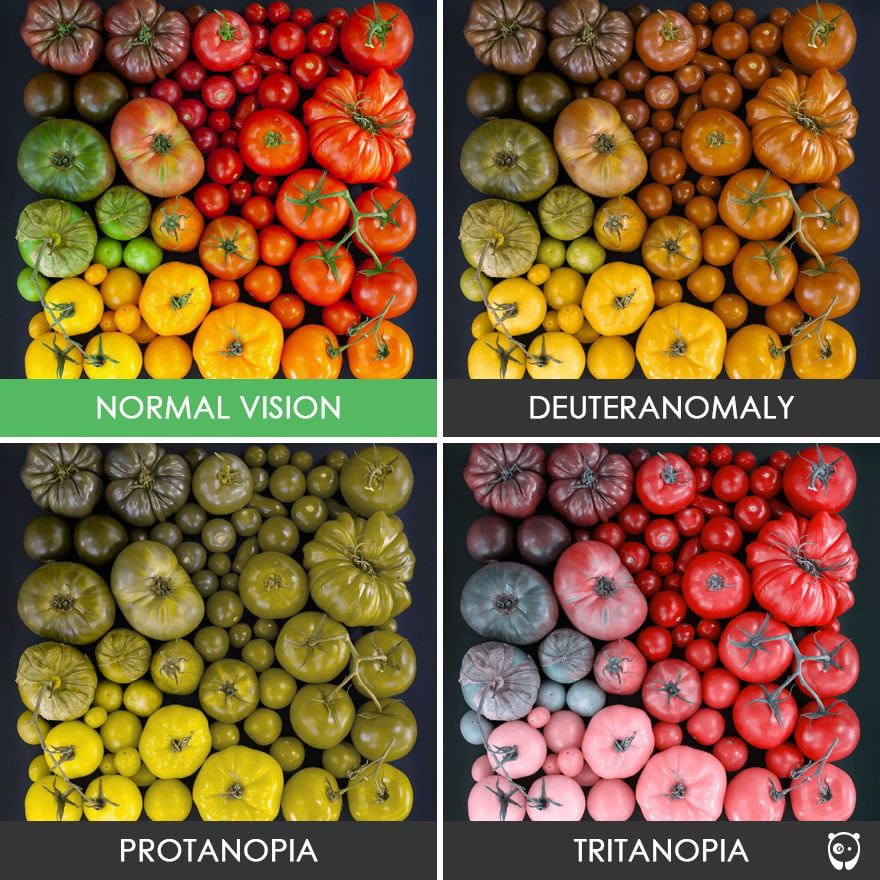
Red-Green Color Blindness
The pigment in the cone of the eye that is responsible for seeing either red or green does not function properly. This causes either red to look more like green and vice versa. However, there are some conditions in which those pigments are not present at all and this causes red black since the eye is unable to detect that colors of the light spectrum.
- Protanomaly: This condition affects the pigment in the red cones. Red, orange, and yellow appear greener and other colors may appear dimmer. Protanomaly does not usually interfere with everyday functioning.
- Protanopia: With this type of red-green color blindness, no red cones are functioning. Since red cannot be perceived it appears black. Shades of orange, yellow, and green all appear yellow.
- Deuteranomaly: This is a condition in which the pigment found in the green cones are abnormal. Yellow and green more red and violet and blue may appear similar. Like protanomaly, this does not usually interfere with everyday functioning.
- Deuteranopia: There are no working green cones with deuteranopia. Red becomes browner and greens are more beige.
Blue-Yellow Color Blindness
There are two conditions of blue-yellow color blindness, one in which there is the limited function of the blue pigments and the other where the blue pigment is completely absent. Both of these conditions are considered very rare.
- Tritanomaly: This effects the blue cones with limited functionality. Blues appear closer to green and make it difficult to tell yellow and red from pink.
- Tritanopia: This is a complete lack of blue cone cells. Blue appears to be green and yellow looks like violet or grey.
Monochromatic
Monochromatic vision can be caused by a severe deficiency in the pigments of the cones or a complete lack. Monochromatic vision is a condition that is very rare and is often accompanied by other visual impairments such as nearsightedness, reduced visual acuity, and even photosensitivity.
- Cone monochromacy: In this form of color blindness, two of the three cones fail to work. There is a red cone, green cone, and blue cone monochromacy. This makes it hard to identify colors since the brain needs multiple colors to compare to.
- Rod monochromacy or achromatopsia: Rare and severe, this condition has no functioning pigment cones in the eyes. This causes a colorblind person to see in black, white, and grey. This also leans towards photosensitivity as the rods of the eye respond to light. This may also present with nystagmus, unusual eye movements.
Color Blindness Tests?
Eye care professionals can diagnose color blindness fairly quickly. There are several tests that have been in use for years and vary in the requirements for color discrimination.
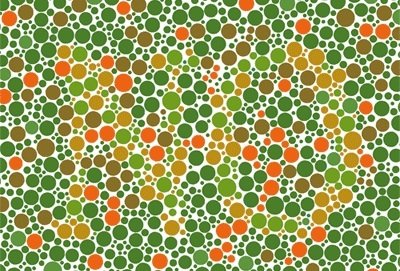
As with anything involving vision, results may be affected by ambient lighting, the condition of a printing, or even differences in computer monitors. If a issue with color detection is suspected, see an eye specialist to confirm.
Ishihara Color Test
This test is the most common test used to detect color blindness. It was developed during World War I by Dr. Shinobu Ishihara and improves on a German test, which existed at the time.
It consists of a series of plates which have an image, usually a number or squiggly line, made of dots of different shades of color. It cannot only determine if color blindness is present but may also reveal the severity of the condition. Color blindness can usually be detected within two to three plates.
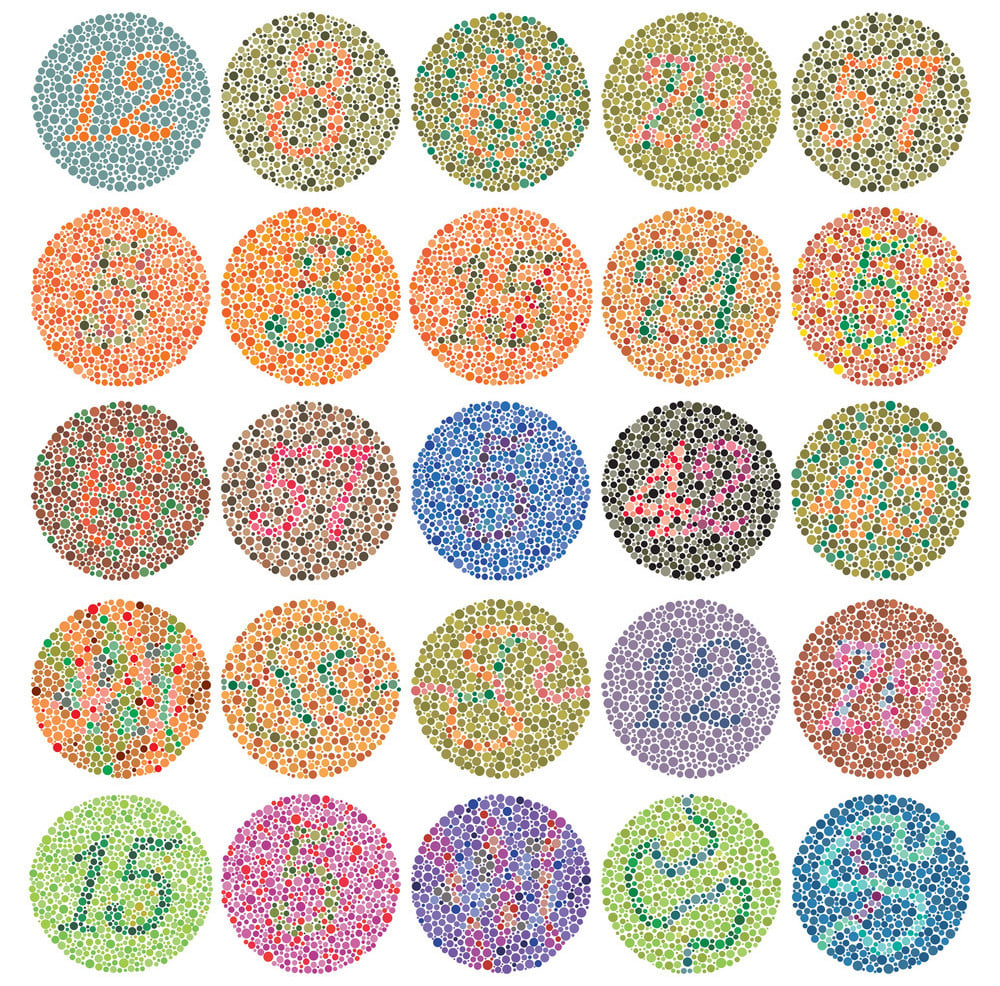
It may have some discrepancies due to being a printed plate and therefore being dependent on the quality of the printing.
Cambridge Color Test
This test is very similar to the Ishihara Test except it is administered on the computer. It shows the image of a letter C made of different colored dots. Respondents press a button to indicate whether or not they perceive the letter. This test may remove some of the discrepancies found in the printings of the Ishihara test.
Anomaloscope
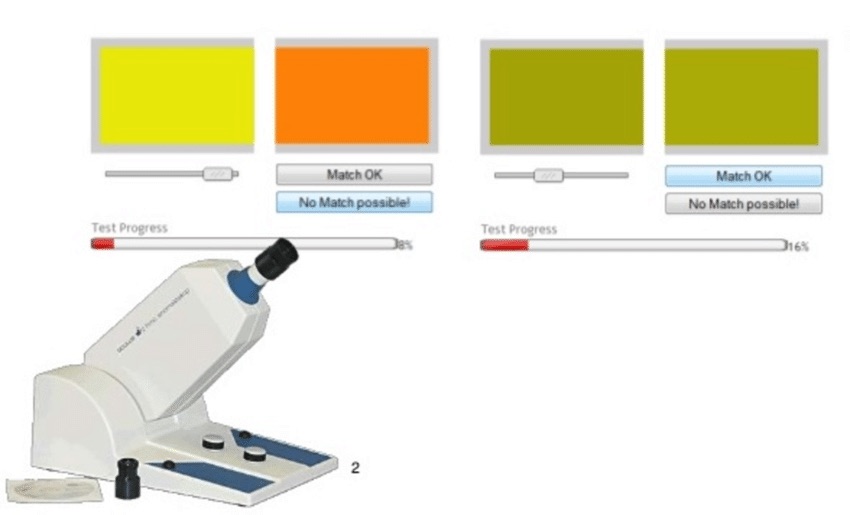
This test may be considered one of the most accurate test when diagnosing color blindness. It asks the respondent to make a test color match a sample color and report whether or not a match is possible. It then gives a report that shows whether or not color blindness is present and which colors are affected.
HRR Pseudoisochromatic Color Test
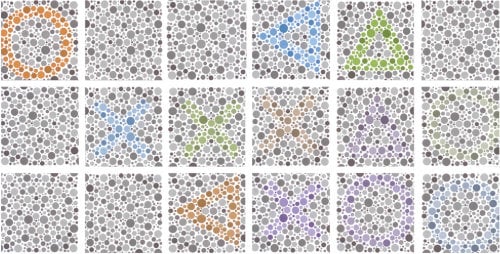
This is another test which uses plates to test for color blindness. An image is presented in a monochromatic background using different shades of a target color. It is very similar to the Ishihara and Cambridge test and is just as accurate.
Farnsworth-Munsell 100 Hue Test
This is an assessment of hue discrimination. This test can help to reveal the severity of a colorblind person’s condition. Many people who attempt this assessment may find that they suffer from a mild form of color blindness of which they were previously unaware.

This test asks respondents to order a series of 100 plates or pegs in order of hue. Some employers use this test before hiring, since there are few jobs, which depend on subtle color perception. This includes graphic design and food quality detection.
Farnsworth Lantern Test
This is an assessment of ability to detect different colors of light used by military vessels. It is given to Naval sailors and pilots who may be required to determine the presence and meaning of different lights. The test consists of a lamp with a vertical light of 9 colors and the respondent is expected to compare them.
There are varying degrees of color blindness acceptability based on the branch of the armed forces, so minor color blindness may not prevent enlistment.
What Are The Effects Of Color blindness?
School
Color blindness is usually diagnosed in childhood, as children are required to interpret information that has been color-coded. This includes visual information such as graphs and charts, which usually have differently colored sections to separate the information.
Children may also experience difficulty in choosing the correct color of crayon or paint. This can make art classes challenging.
Food
People also depend on color acuity to determine the ripeness of fruits and vegetables. Rot is often detected by a darker shade of the normal color. Thorough cooking of meat is often stated in terms of the color of the interior of the meat.
Everyday Tasks
Traffic lights can be a challenge but most have a predictable orientation of color progression with green on top and red on bottom. When presented with traffic lights in a horizontal orientation, it may require more mental attention to attend to the new sequence of lights.
Reading maps may require assistance if they are color-coded by area or feature and buying clothing that match in color can be difficult, however many smartphone apps have been developed to assist in this matter.
Some countries limit driving licenses for colorblind citizens. It has been argued that it is a matter of safety due to traffic lights or warning signs that are present on the road.
Careers
Color blindness may also limit career choices, particularly those which rely on a ability to differentiate between warning signs of varying shades but do not include textual clues.
Some careers rely on being able to see all shades of color such as mixing paints or graphic design. Jobs which require different types of cable, like computer networking or electricians, may not be accessible to those who are colorblind.
Commercial piloting requires unaffected color acuity, but it is possible to obtain a pilot’s license for smaller planes such as those used for agriculture. color blindness may not allow people to apply for the Air Force but does not limit other branches of military service.
What Are The Treatments For Color Blindness?
As it is primarily a genetic disorder, there is no cure for color blindness. It is often not detected until a child is old enough to indicate that they are experiencing issues with color. However, there are methods to allow a colorblind person to experience as little interference with everyday functioning as possible.
People with red-green color blindness can use tinted lenses to help them detect these colors more accurately. These can be glasses or contact lenses. They may have issues in dim light or indoors, since ambient lighting can affect color perception.
Technology has improved to the point that many smartphones now have applications, which can detect the color when a photo is taken, or the user points the camera at an object. These apps can be useful when looking for ripe fruit in the supermarket.


